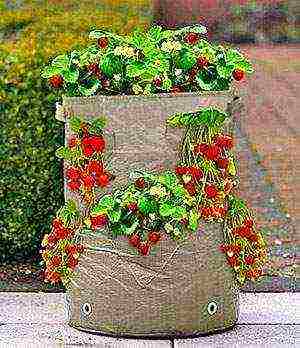Content [show]
After a winter walk or a ski run, hardly anyone will refuse a cup of warming aromatic thyme tea.
And so that such tea can be brewed at any time of the year, you need to plant thyme in the garden or right at home, the cultivation of which is not difficult. We will learn how to grow this plant indoors and on a personal plot, and how to care for it in order to get a decent harvest of fragrant greenery.
Thyme: planting and care in the country
In order for thyme bushes to give a lot of greens used in the preparation of drinks, salads and other dishes, and for health purposes, you need to grow it correctly.
Planting thyme
To grow thyme correctly, we follow several planting rules:
Choosing a landing site
The plant prefers to grow in open sunny warm areas, but it is also grown in diffused light - under trees whose crowns let the sun through, for example, under a mountain ash.
Preparing the soil
The site should have fertile, well-breathing soil. If the soil is poor, add humus - 4 kg per square meter. And so that the soil is somewhat sour, as thyme loves, we add peat to it.
Along with humus and peat, you can fertilize the soil with mineral fertilizers: superphosphate, potassium salt, ammonium sulfate or ammonium nitrate, adding them in accordance with the instructions.
Sow seeds for seedlings
We sow seedlings from early to mid-March. We buy containers for seedlings, where there are drainage holes, and we fill them with fertile soil, which can be bought at a garden store. Scatter achenes over the surface of the earth, lightly sprinkle with soil and spray with water from a container with a spray bottle.
We cover the boxes with cling film and place them on a warm windowsill, where the temperature is kept at least 20 degrees Celsius.
We transplant seedlings to the site
We transplant the grown seedlings into a garden bed or flower bed towards the end of May, having previously hardened them, starting a week before planting, take the seedlings out into the street for 1.5-2 hours.
We plant the plants 20 cm apart, observing a row spacing of 35 cm.
If you live in warm climates with early springs, seedlings may not need to be grown. In mid-March, we randomly sow achenes in a flower bed or on a plot, lightly sprinkle with soil and water. Only the seedlings will hatch not in a couple of weeks, as with the seedling method, but a little later - after 25-30 days.
When shoots appear, be sure to thin them out in order to grow strong plants. Thyme with this method will bloom only in the second year.
 Thyme: planting and care in the country
Thyme: planting and care in the country
Creeping thyme: care
In order for strong plants with a cap of green leaves to grow from seedlings, it is important to properly care for them: water, feed, get rid of weeds.
Watering thyme
Timely watering is important for the plant. Although it easily tolerates dry soil, during flowering this negatively affects the brightness of the flowers: they become pale.
We water the thyme moderately and often: an excessive level of moisture is also useless for it - the plant will begin to wither and die.
Weeding and loosening thyme
It is equally important to weed a flowerbed or a section of weeds in time: they take away moisture and nutrients from the bushes.
After weeding, we loosen the aisles and places between the plants with a garden herringbone to give the roots more air, and water.
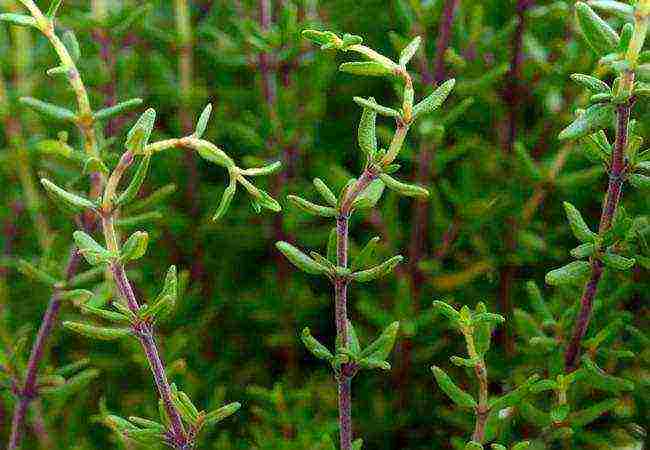 Weeding and loosening thyme
Weeding and loosening thyme
Feeding thyme
This plant cannot be fed with fresh chicken droppings and mullein: from organic matter we add only humus or ash from burning wood. After a couple of weeks from the emergence of seedlings, we fertilize the seedlings with ash or humus, or better with urea.
We carry out fertilizing with mineral fertilizers only next year, not earlier.
Pruning thyme
If mature bushes prevent neighboring plants from receiving sunlight, they can be trimmed a little.
Wintering thyme
So that the creeping garden thyme, which we took care of according to all the rules, does not freeze in winter, we must insulate it. In October, when leaves fall, we spud the bushes to a height of about 20 cm and cover with a 10 cm layer of mulch, for which dried wood shavings or dry foliage are suitable. Put coniferous legs on top of the mulch.
After the snow falls, sprinkle it on the beds or beds with thyme to make snowdrifts.
When to cut thyme
Thyme can be cut in dry weather from 9 am to 7 pm, when there is no dew on the plants.
- We selectively cut leaflets for food every summer.
- If we are talking about harvesting thyme for drying for further use for medicinal and culinary purposes, the flowers, leaves and stems of the plant are collected at the time of active flowering, usually in July.
The main thing is not to pull out the plant with roots, so as not to destroy its turf, which is necessary for reproduction. We take scissors and cut off only the aerial parts above the lignified areas of the stems, rejecting damaged and diseased shoots.
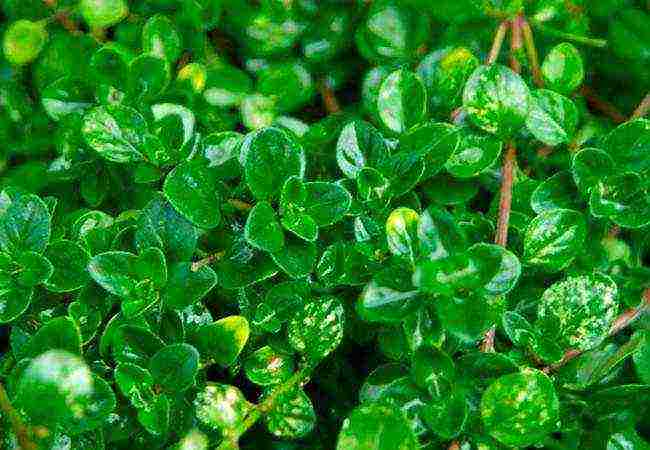 Thyme: planting and caring for the windowsill
Thyme: planting and caring for the windowsill
Growing thyme on a windowsill
Thyme on the windowsill is grown in two ways: from achenes or cuttings.
Thyme: planting and caring for seed growing
To grow indoor thyme from seeds, and get spicy greens even in urban conditions, we follow this plan:
- We buy a flower pot no more than 20 cm high.
- We spread the bottom of the pot with a 2-centimeter drainage and fill up the fertile soil.
- We spill the soil with warm water, put a few achenes on top, sprinkle them with a centimeter layer of earth and water with a spray bottle.
- We cover the pot with foil, put it on a light, but not sunny windowsill, and make sure that the ground remains moist until the sprouts appear.
Seedlings will be born after 10-14 days, after which we must thin out the plantings in order to grow strong plants. And when they are old enough, we carefully plant them in separate pots.
Growing thyme using the cuttings method
To grow thyme on the windowsill using cuttings, in the fall, after flowering, we cut off several shoots from the plants and do the following:
- We tear off the leaves from the bottom of the cuttings.
- We fill the pots with drainage and earth (ideally, soil intended for cacti), spill the soil with warm water.
- We plant the cuttings in pots and sprinkle with soil.
You can also put the cuttings in a jar of water and wait for the roots to appear, and only then plant them in pots.
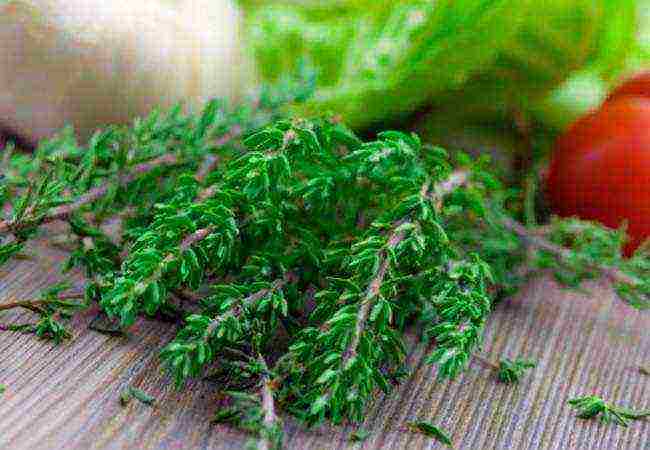 Growing thyme using the cuttings method
Growing thyme using the cuttings method
Thyme: houseplant care
Indoor thyme requires similar care as garden thyme, and it consists in the following:
- Watering and loosening... Before the cuttings have new leaves, we water them in a day, after - as the soil dries up, avoiding stagnation of water. We loosen the soil regularly: the thyme roots need normal air circulation.
- Lighting and temperature control... Pots with seedlings need sunlight and a temperature of at least 17-20 degrees, so we keep them on the southern windows: there they grow and develop better.
In case of insufficient lighting, the leaves of thyme lose their pronounced aroma, and the stems become elongated.
Important: in order not to destroy the plant, we cut off the leaves for eating or for other purposes selectively, and not in large quantities: the stems should not be naked.
So, you know how you can grow thyme, the cultivation of which is possible both in the garden and right in the apartment. Grow it in any conditions and get fragrant and healthy greens all year round!
Thyme (thyme) is valued not only for its medicinal properties, but also as an excellent spice, flavoring seasoning for many dishes and aromatic drinks in cooking. It is unassuming to care for, so it is often grown both outdoors and in a room on a windowsill. Many summer residents, highly appreciating the decorativeness of some varieties, use thyme to decorate the site. We will tell in the article how to grow thyme from seeds in the country or at home, how to squeeze, what care features are required for the plant.
Types and varieties of thyme (thyme)
The genus of thyme is very extensive, in nature there are more than 200 of its species. When breeding varieties, breeders mainly use the following types of thyme (thyme):
- ordinary;
- creeping;
- lemon-smelling;
- early.
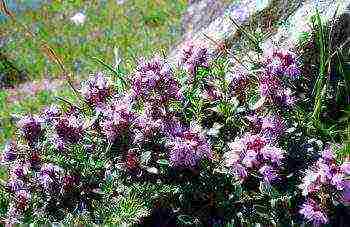
Some species are successfully used as flowering and ornamental shrubs for arranging flower beds, decorating hills, borders.
The commercially available seeds of various varieties of thyme (thyme) are suitable both for open ground and for growing in a room on a windowsill. Plants will decorate a room or garden, and freshly picked leaves and shoots will add a wonderful aroma to food and drinks and will be used in recipes for traditional medicine. Read also the article: → "Spicy herbs in the country."
5 best varieties of thyme (thyme) for home growing
The most popular varieties are presented in the table:
| N / a | Variety name | Characteristics |
| 1. | Snake | The rapid appearance of the first greenery for cutting, the leaves are small, the flowers are bright, pink with purple, the shoots creeping up to 35 cm |
| 2. | Aibolit | Early ripe, well leafy, small leaves, light pink flowers with a purple tint |
| 3. | Citric | The height of the semi-shrub is up to 30 cm, the flowers are white, the leaves are fragrant with a lemon-spicy taste, slightly pungent |
| 4. | Nectar | Creeping plant, pink flowers, stem height up to 25 cm, large yield of spicy foliage |
| 5. | Rainbow | It grows up to 20 cm tall, the leaves have a very strong aroma, a high content of vitamins and microelements |
Thyme breeding methods
Thyme can be propagated in many ways, each of which is applicable in one case or another.
Seedless method (by seeds)
- Seeds are sown in open ground in spring, buried in well-moistened soil, but no more than 0.5-0.7 cm, since they are very small. Top them lightly sprinkle with sand or peat. The plantings are covered with polyethylene until the first shoots appear, usually it will take about 2-2.5 weeks.
- Plants, especially erect varieties, are usually placed in beds in a pattern of 40-60 cm between rows and 10-20 cm between plants in a row.
- At first, the thyme grows very slowly, after the appearance of the first true leaves, it is thinned out. For decorative purposes, it is possible to grow with a solid carpet, without thinning.
Savory (thyme, thyme) - grown from seeds
- The soil must be constantly loosened and carefully monitored so that a crust does not form.
- Good results are obtained by sowing before winter, on frozen ground. In areas with severe winters, adult plants in the fall are spud and covered with spruce branches.
Tip # 1. In order to prevent thyme from freezing out in areas with severe winters, planting is mulched, it is often grown as an annual. Individual specimens can be transplanted into pots in the fall and installed on the windowsill.
Seedling method of breeding thyme
- Seedling growing is considered more reliable. Since the seeds of thyme are quite tough and the sprouts that appear are very small, they can easily die in the open field.
- For growing seedlings, containers with a depth of 8-10 cm are used. The bottom is filled with drainage material (2-3 cm), because the plants need a good outflow of water. It can be fine gravel, expanded clay, crushed stone.
- A soil mixture is poured on top, lightly compacted and abundantly moistened with a sprayer.
- Seeds are spread over the soil, trying to avoid excessive thickening, and lightly sprinkled with sand. The container is covered with foil or glass, creating a humid and warm microclimate, and regularly ventilated.
- When sprouts appear (after 2-2.5 weeks), the containers are transferred to a cooler and well-lit place. At first, the film is periodically moved aside for a while for airing and hardening the sprouts, removing it on warm days, and later completely removed.
- Young plants in the phase of 2 leaves dive or thin out, leaving a feeding area for one sprout of about 2x2 cm.
- Seedlings can be planted in the ground after 60-65 days. For this, cloudy days are chosen, preferably after rain, the plantings are shaded for the first time. Read also the article: → "Spicy herbs - we grow ourselves."
Tip # 2. Thyme seeds will germinate faster at elevated temperatures and humidity; when sprouts appear, they must be gradually reduced.
Propagation by cuttings and root layers
- In creeping species, the processes can take root on their own, overgrowing with roots. Root layers are cut off from the mother plant, dug up and planted.
- Some species are propagated by lignified cuttings, which are cut into 3-5 cm, pre-rooted in a greenhouse or immediately planted in a permanent place under a film for rooting.
Growing thyme by dividing the bush
- In the spring, large bushes are dug up and the roots are carefully disassembled. The plant is divided into separate parts with shoots of the root system. They are planted in moist soil with an embedment of 4-6 cm.

Thyme can be propagated by dividing the bush, embedded in moist soil to a depth of 4-6 cm
Growing at home
- On the windowsill, thyme can be grown all year round, using both seedless and seedling methods.
- In the presence of adult plants, vegetative propagation methods are applicable - by cuttings, layering and dividing the bush.
- For home cultivation, varieties with compact sizes and erect stems are suitable.
- To avoid excessive stretching of the shoots, additional lighting will be required in the autumn-winter time.
Features of care at home and in the country
In order for the bushes to always be lush, green, it is necessary to observe the conditions of cultivation and care.
Watering and loosening the soil
- Loose and light soils with a neutral reaction are preferred, thyme will not grow on clay soils.
- The main condition is good drainage, since the plant does not tolerate even the slightest waterlogging and stagnation of water. Good results are obtained by using fine gravel as mulch.

Using fine gravel as mulch keeps water from stagnant
- The moisture permeability of the soil can be ensured by using equal parts of soil mixture, sand and peat for germinating seeds and rooting cuttings.
- Plants will need loosening of the soil, removing weeds.
Requirements for watering bushes
- Watering should be moderate, but constant, it is not necessary to allow the soil to dry out.
- In dry summer periods, with active regrowth of shoots in spring and during flowering, watering is slightly increased.
- Waterlogging causes great harm to plants. If it rains for a long time and the soil becomes saturated with moisture, the roots may begin to rot.
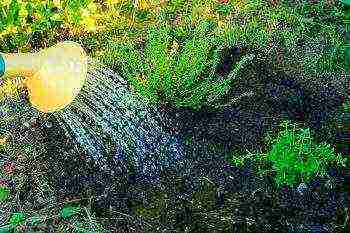
Watering should be moderate, both waterlogging and overdrying of the soil is not allowed
The need for lighting in summer and winter
- The plant prefers well-lit and sunny places.
- It can withstand light partial shade and shading, but at the same time it will bloom poorly and stretch out strongly, losing its decorative effect.
- When grown on a windowsill in winter, illumination of 40-55 W / m2 will be required. Read also the article: → "How to grow onions and other greens in an apartment."
Indoor temperature and humidity
- In open ground, excessive overheating, overdrying or waterlogging of the soil must not be allowed.
- Before the first shoots appear, a higher temperature and humidity (+ 20-22 ° C) will be required. When growing seedlings, the temperature is gradually reduced (up to + 15-18 ° C), hardening the plants.
Fertilization and dressing
- Before planting, organic matter (2-3 kg per 1 m2) and nitrophosphate (30 g) are introduced into open ground.
- Plants in the open field are fed with complex fertilizers two or three times a season, especially they need feeding after harvesting raw materials.
- When growing seedlings, plants are fed 1-2 times with universal fertilizers with microelements, following the instructions. You can use wood ash and spraying with Epin-extra.
Shoot picking time
- In the first year (when grown from seeds), individual, longest shoots are selectively cut off.
- For medicinal purposes and for the preparation of drinks, thyme is harvested in dry weather, during flowering, which begins in the second year. In this case, the stem is cut off, leaving 7-10 cm at the root. The second harvest can be repeated in the fall, as the shoots grow back.
- For eating, use young shoots with delicate leaves.
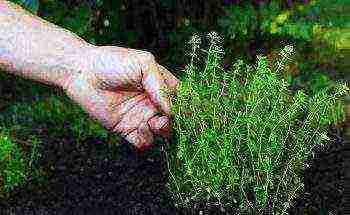
For culinary use, young shoots and leaves are plucked
Thyme care rules
The basic rules of care are presented in the table:
| Care type | Peculiarities | Recommendations |
| Watering | Moderate but regular | Thyme does not tolerate waterlogging, stagnant water and strong drying out of the soil |
| Temperature | + 15 ... + 20 ° С | A higher temperature is required before the emergence of shoots, then it is gradually reduced |
| Agricultural practices | Weeding, loosening | The soil needs regular loosening so that the formed crust does not interfere with the access of oxygen |
Answers to questions about growing thyme
Question number 1.I grow thyme in the open field, but it blooms and develops poorly. What is the reason?
It is possible that the soil is not suitable for the plant, it is too acidic. Other reasons are the location of the plantings in the shade or stagnant water in the garden.
Question number 2.Thyme, planted on an alpine hill, grows and stretches very much, its decorative effect is lost. What can be done?
For an alpine slide, it is best to change the variety, choosing creeping species with miniature and compact bushes for planting.
Question number 3.Is it possible to sow thyme seeds in open ground not in spring, but in summer or autumn?
Sowing can be carried out at any time, but it must be borne in mind that young plants must have time to root sufficiently before the first frosty days. For the winter, they should be huddled and covered.
Question number 4.When is the right time to cut thyme for medicinal purposes?
Most of the useful substances are contained in flowering thyme, therefore cutting is carried out during flowering.
Question number 5.What can be done to make potted plants on the windowsill more compact?
More compact bushes with a dense green mass are obtained with regular pruning, overgrown shoots are cut to a lignified base. For home cultivation, it is better to select low, upright varieties.
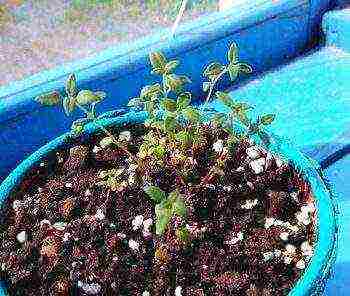
When grown on a windowsill, the thyme is placed in the sunniest place.
Review of the cultivation of thyme
Fragrant thyme is known for its medicinal and taste properties, so I have been growing it for several years in my summer cottage, and it invariably pleases us with its decorative effect. Recently, I decided to plant it at home so that when I cook, there are always spicy leaves at hand.
There is nothing super complicated in growing it, but you still have to take into account some basic points. In the open field, the seedling method is more suitable, so the thyme takes root better. The seeds are very small, germinate for a long time, so you need to keep an eye on them, observe the regime of high temperature and humidity.
But even when the first shoots appear, they are very tiny and grow slowly, the weeds can destroy them, this will also have to be constantly monitored. But in the spring, I visit from time to time, so it is more convenient for me to bring ready-made seedlings grown on the windowsill with me.
- For planting seeds for seedlings, I use low containers, on the bottom I spread a layer of fine expanded clay, well washed and scalded with boiling water. Thyme does not tolerate stagnant water, and containers should have good drainage.
- It is best to take the soil for the initial germination of seeds that is not rich in nutrients. It might just be a mixture of sand and peat, because if you use a regular nutrient mixture, the high humidity will encourage mold growth.
- Before planting, I water and compact the soil abundantly, then I spread the prepared seeds on its surface, trying to distribute them evenly, and cover the container with glass (you can use a film). I put it in the warmest place, constantly keep the soil moist, and after about 2 weeks the first shoots begin to appear.
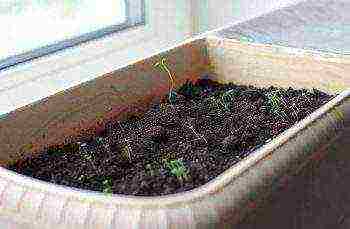
Thyme shoots appear in about 2 weeks
- In a state of 2-3 true leaves, I dive seedlings, but I already make up the soil from equal parts of peat, sand and a universal soil mixture. The plant will be ready for planting in the country in 2 months.
- I prepare the land in the garden in advance, dig it up, mixing it with sand. I add a universal fertilizer, as well as well-rotted compost. Please note that the soil should be light and loose; heavy clay soils, on which the water will start to stagnate, will not work. At first I shade the plants, then I provide timely watering, weeding and loosening of the crust.
- I leave a little seedlings for growing in the kitchen. On cloudy and winter days, the thyme will need additional lighting, otherwise it will stretch a lot. I especially liked the varieties "Lemon" and "Medoc".
How to avoid mistakes when growing
Mistake # 1.Growing thyme on clay soils where water stagnates. The roots start to rot and the plant gets sick and disappears.
The soils should be light, with the addition of sand, moisture and air permeable. Plants need good drainage.
Mistake # 2.Due to the placement of the thyme in the shade, it is very stretched, sick and does not bloom well.
How to avoid? Plant light-loving thyme in well-lit, sunny areas.
Rate the quality of the article. We want to be better for you:
This plant is well known to our mistresses. Someone knows it as thyme and actively uses it in cooking, while someone knows it as thyme - a very useful herb for medicinal purposes.
In both cases, they often deal with dried grass, and few people thought about the fact that, in addition to its usefulness, thyme is also a very beautiful bush, with flowers of an incredibly pleasant shade and aroma.

Thyme bush in a pot
We also associate thyme with the celebration of the Trinity. On this day, it is customary for them to decorate houses. Wreaths from it are used to frame icons with the face of the Virgin, which gives the latter a festive look.This is where the additional popular name of the plant came from - the Mother of God.

Thyme wreath for home decor
The healing possibilities of thyme are truly wide. His decoctions are drunk with a strong cough, diseases of the larynx, they treat skin problems by lubricating and applying lotions to the affected areas. Thyme helps with neurotic conditions, and thyme tea relieves fatigue. Thyme is widely used in official medicine. Its essential oils are found in many medicines. On its basis, preparations for children have been created. In general, the thyme bush is a real first aid kit on the windowsill.

Thyme is a storehouse of nutrients
If you have a summer cottage, then it is worth planting thyme on the site. With its help, you can decorate the landscape in an original way. In the evenings, sitting in the gazebo, you will bask in the pleasant aroma of thyme.
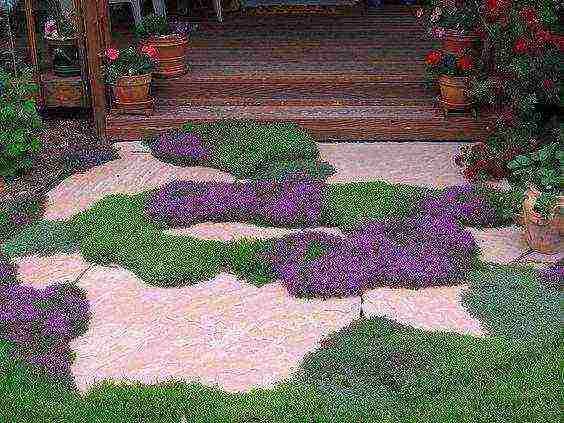
Thyme will delight not only with bright colors, but also with a wonderful aroma.
Origin
Thyme is a plant from the lamb family. This is a rather complex genus. It includes grass and shrubs of small stature, which have a pronounced aromatic effect. The stalks of the grass are woody. They can be upright or recumbent. The height of the bush does not exceed 35 centimeters. Flowers are collected in heads or resemble panicles. They are placed at the ends of the peduncles.
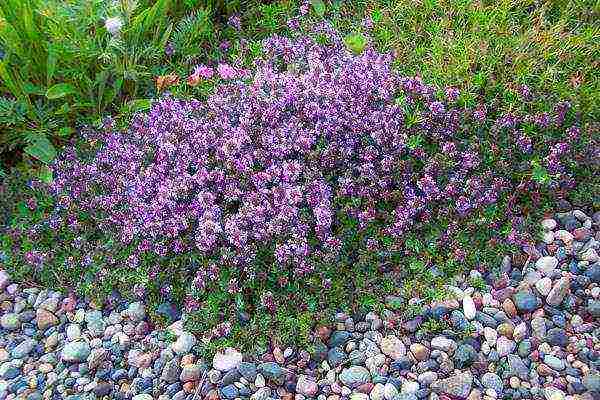
Flowering thyme bush
As for the color of flowers, it should be noted their extreme variety. You can see them:
1. Purple.

Purple thyme flowers
2. White.
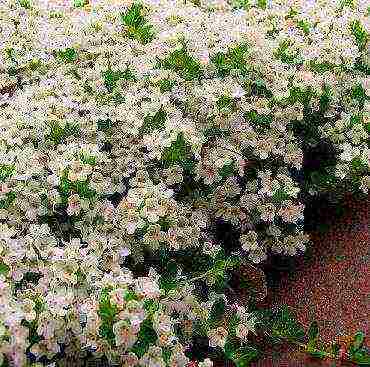
White thyme flowers
3. Pink.
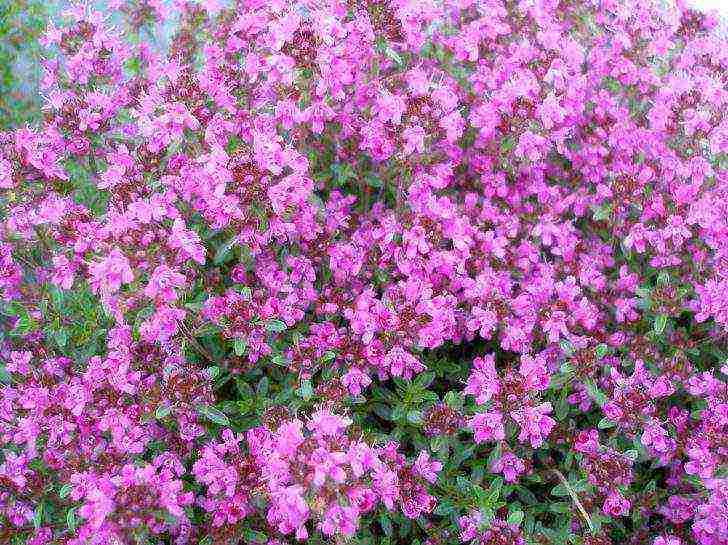
Pink thyme flowers
4. Yellow.
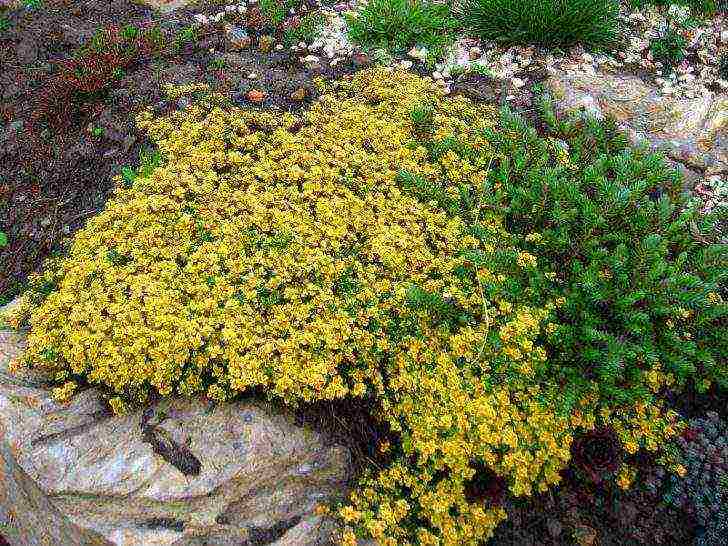
Yellow thyme flowers
But not only flowers give the plant a decorative look. Leaves are also actively involved in this business, which for each variety have their own sizes, as well as an individual shape and a kind of edging along the edges. Creeping species are great for decorating alpine slides and rockeries. Small, beautifully formed bushes will look better on a home windowsill.
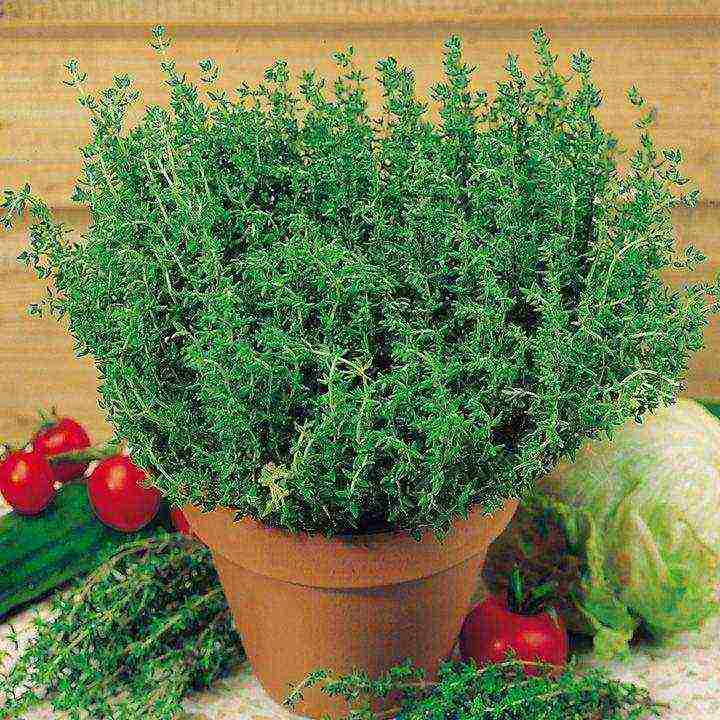
A small thyme bush will decorate your windowsill
Varieties of varieties
"In order to grow thyme, it is enough to adhere to simple rules of care, and there will never be any problems with the plant."
Thyme is presented in an unusually wide variety, but only a few of them, the most unpretentious in care, are recommended for home cultivation.
Common thyme
The height of the bush of this variety is 15 centimeters. This type of herb is most in demand in medicine. The leaves of the plant are small, pubescent along the bottom. Thyme blooms with white or light purple flowers. This type of thyme also includes shorter subspecies.

Common thyme with lilac flowers
Common thyme became the progenitor of the lemon hybrid. Its leaves are distinguished by a subtle admixture of lemon scent. In a young plant, the foliage is almost yellow. As it grows older, its color will change to light green. To maintain the shape and density of the plant, the bush needs a regular haircut.
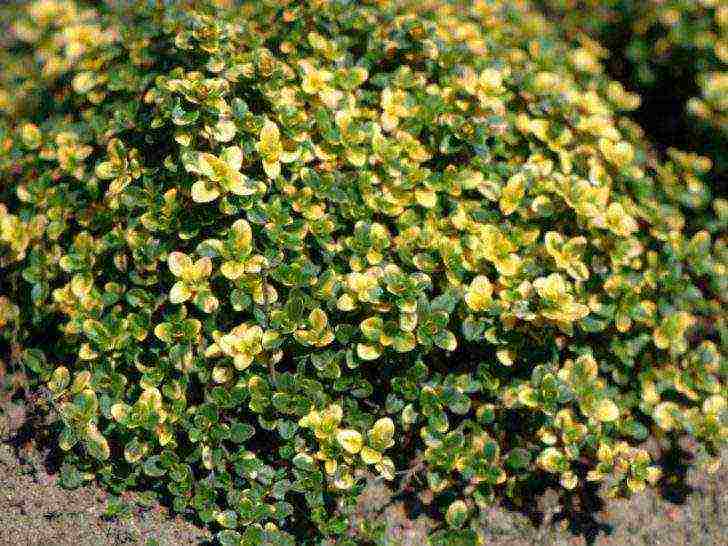
Lemon thyme with mixed leaf color
Dwarf thyme
Miniature bushes are never taller than 5 centimeters. They are characterized by dense island growth. Dwarf types give white, scarlet and red colors.
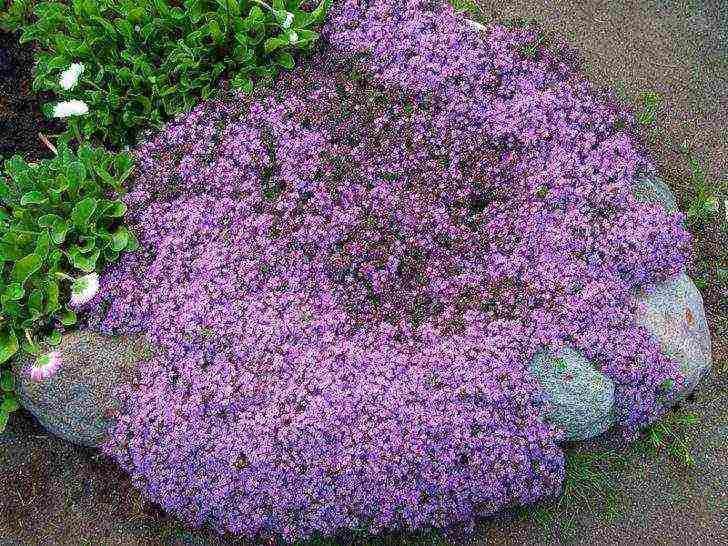
Low-growing dwarf thyme
Creeping thyme
The bush is distinguished by creeping stems and bright pink and crimson flowers. The leaves of such a thyme are quite large, up to 1 centimeter long. The flowering period is the end of summer.

Creeping thyme
Rainbow thyme
The variety, in general, is more suitable for open areas, as it is incredibly beautiful, but it is equally beneficial to keep it on the kitchen windowsill. Why? Because it is this subspecies that we use for food and is a seasoning for many dishes. The rainbow thyme is quite tall, blooms purple and pink, and can live for five years with proper care.
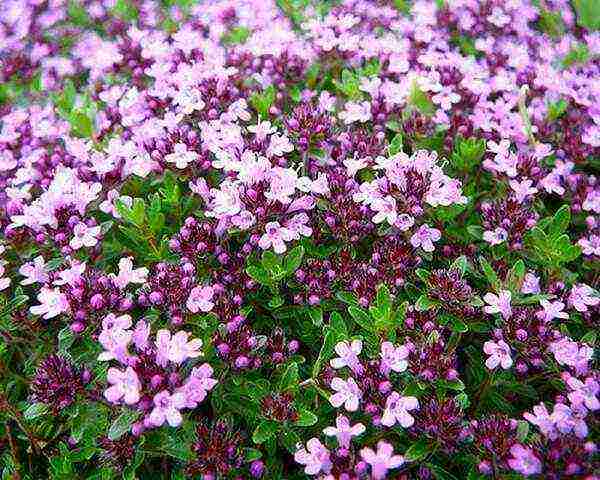
Rainbow thyme
Thyme Bogorodsky
This is also a variety with thin creeping stems.It can be used in window decoration. In the country, it is often a decoration for fences, walls of houses and gazebos. The flowers are lilac-pink, exuding a bright aroma. This type of thyme has a bitter taste, so it is not used in teas.
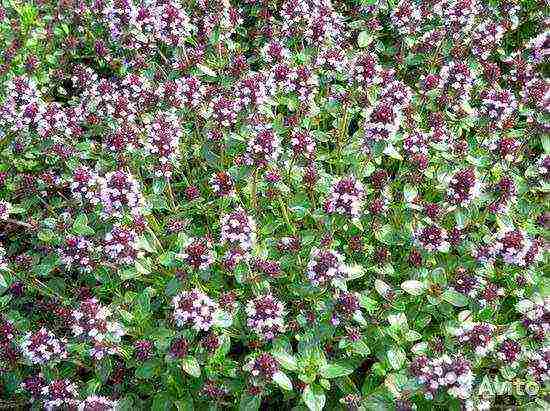
Thyme Bogorodsky
Thyme lovers show great interest in the dwarf variety Elfin, which grows with a dense "pillow" of fifteen centimeters in diameter, and the brightly blooming varieties of Alba, Cossineus, Splendens, delighting with white, carmine-red and scarlet flowers, respectively.

Elfin thyme
Thyme is completely unpretentious. In order to grow it, it is enough to adhere to simple rules of care, and there will never be problems with the plant.
Seed thyme
To grow a spicy plant at home, there is absolutely no need to spend money on the purchase of seedlings, which, by the way, will still have to be searched thoroughly. It is much easier to use seeds for this. Thyme planted in a pot will grow normally on a sunny balcony, as well as on a windowsill, provided a regular ventilation regime is provided.
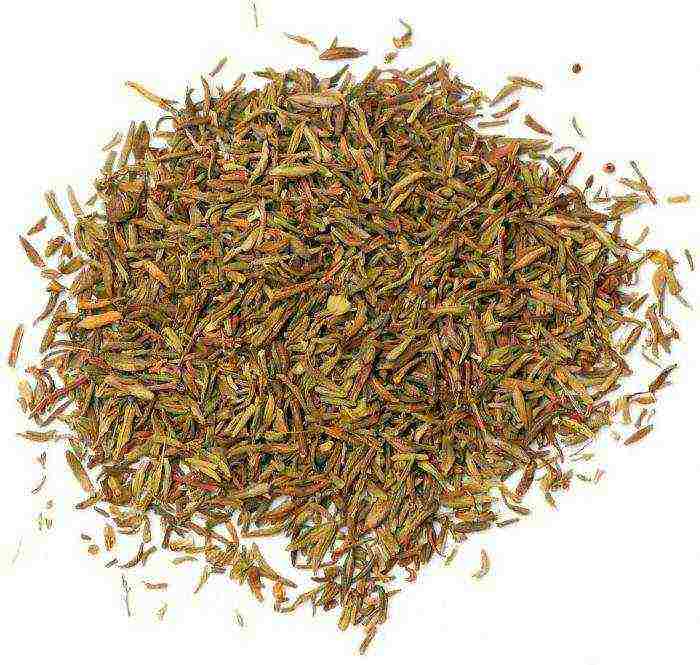
Thyme seeds
The shrub has a small root system, making it an ideal spice for home growing. Thyme on the window will also be aesthetically pleasing. Its flowers will delight the eye, and its sophisticated aroma will delight the sense of smell.
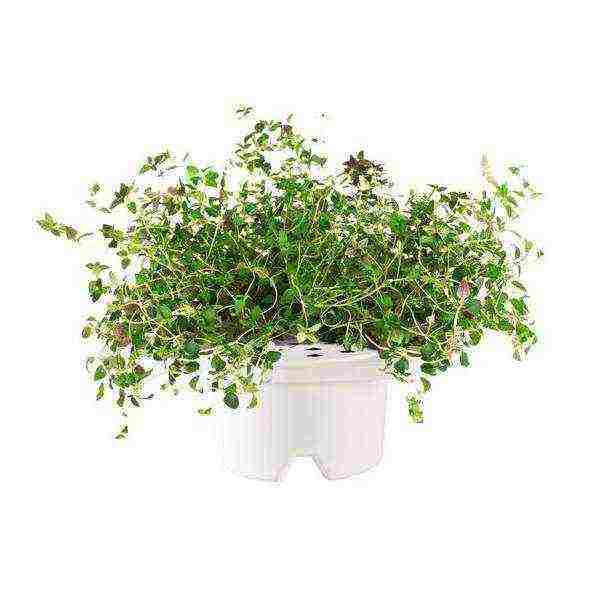
Thyme is ideal for growing on a windowsill
Action plan:
1. Prepare a small pot, 15 centimeters deep.
2. Cover the bottom with drainage. A two-centimeter layer is enough.
3. Prepare the soil. We mix it with vermiculite.
4. Moisten the soil from the spray bottle and place it over the drainage.
5. Shade the pot until the first growth appears. This will help the sprouts to grow stronger and not burn out in the sun.
Thyme seed germination is excellent, so you can leave the strongest sprouts for divorce and remove the rest.
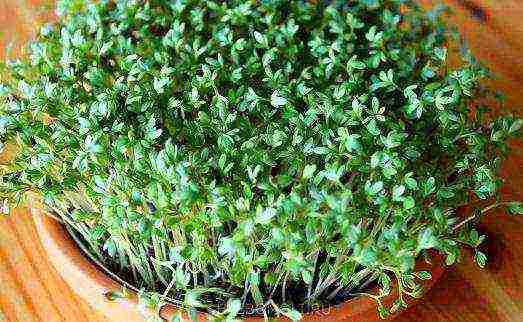
Thyme is ideal for growing at home
Thyme from cuttings
"In a situation where the decision to breed thyme on the window came spontaneously and at the moment X there were no pots or soil mixture in the house, green cuttings can be left to root in glasses, either made of dark glass or specially darkened."
If you are not ready for the lengthy process of growing thyme from seed, you can try to dilute it in an accelerated way. To have fresh spicy herb, you need to stock up on pots, empty the windowsill, and buy fresh thyme herbs from the supermarket. Then follow the instructions
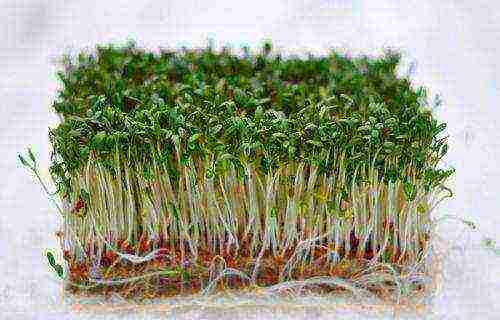
Thyme sprouts
Having brought a package of thyme twigs, carefully unpack it and select the best preserved twigs from the total mass. Make an oblique cut on the stems. This requires a sharpened knife. Tear off the leaves located below and lower the prepared cutting into the water, leaving it there for the next five or even six hours. It is very good if you use melt water warmed to room temperature. The addition of honey (half a teaspoon will be enough for half a liter of water) or such a drug as Epin-Extra (calculation of 2 drops per glass) can contribute to better rooting.
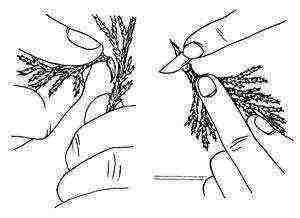
Preparing thyme cuttings
Prepare the pots while the cuttings are settling in water. They need to be scalded with boiling water and covered with expanded clay bottom. A layer of fertile soil is poured onto the drainage. It should take up about a third of the volume. The rest of the place will be occupied by calcined sand from a series of coarse-grained. All this is poured with a pink solution of potassium permanganate.
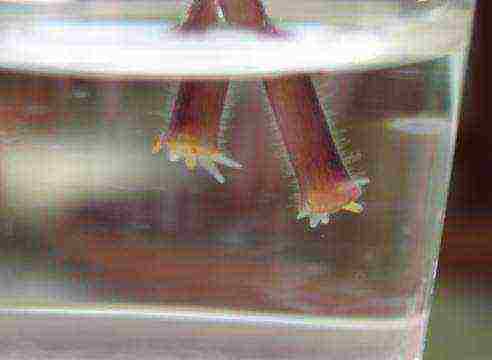
Rooting thyme cuttings
4 cuttings are planted in one pot. After planting, they are sprayed with water and greenhouse conditions are arranged for them. The pot is covered with a half-liter jar, which you will need to remember to regularly raise, giving air access to the shoots. The roots of cuttings form around the second or third week. During this period, banks are also removed.After a crescent from this moment, the seedlings can be planted in separate containers with standard fertile soil.

After rooting, the thyme can be planted
In a situation where the decision to breed thyme on the window came spontaneously and at the moment X there were no pots or soil mixture in the house, green cuttings can be left to root in glasses, either made of dark glass or specially darkened. Water at room temperature is saturated with an activated carbon tablet and several hydrogel granules. Provided that the microclimate of the windowsill is dry and warm, the glass is placed in a plastic bag and, filling the latter with air, tied. Roots with such germination will appear before 20 days. Transplant the seedlings into pots filled with light, fertile soil, being careful not to shave off the swollen hydrogel beads from the roots.
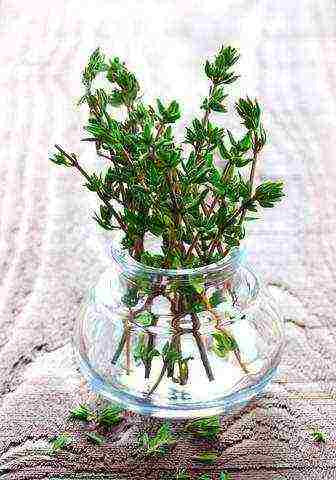
The roots of thyme cuttings appear within 20 days
Watering
Water the thyme in moderation, only when the soil is well dried. Only young sprouts are not planted on dry rations.
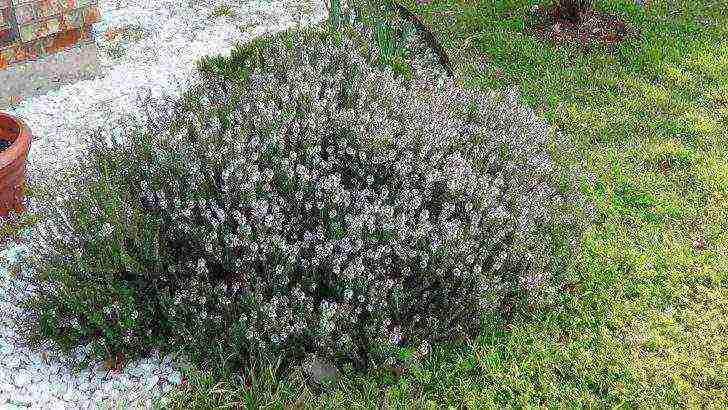
Thyme prefers moderate watering
Thyme bushes are planted in the second year, when new growth begins to grow from the root. The plant, like all herbs and spices, gratefully responds to mineral supplements.

Dividing the thyme bush
Thyme in winter
During this period, it is advisable to remove the thyme from the windowsill and send it, for example, to the glazed balcony, providing the plant with a rest period. The balcony can become his shelter only if there are no too low temperatures on it in frosts. Readings below +5 are cause for concern and the transfer of thyme to another, warmer place
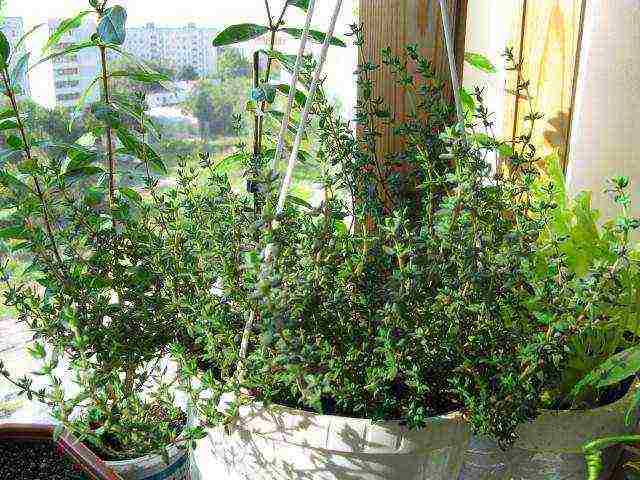
In winter, the thyme bush can be transferred to the balcony
Continuous distillation of thyme is also practiced, but in this case it needs to be provided not only with a warm window sill, but also with additional lighting.
Harvesting thyme
If you want to dry herbs for future use in order to add it to spice mixtures or leave it for decoctions just in case, collect it for Trinity. On this day, it is considered the most saturated with useful substances.
Only flowering plants can be taken. The leafy stems are cut with a sharp knife. Breaking off the branches, you cause irreparable damage to the entire bush.
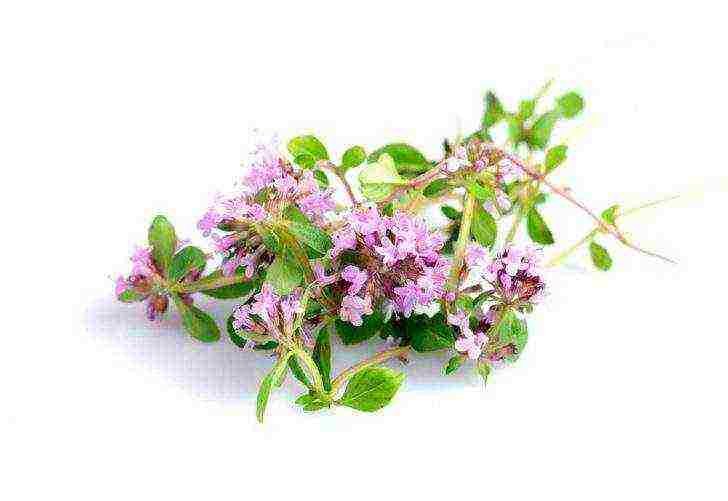
Thyme is harvested during flowering
Thyme should be dried according to general rules, spreading it out on sackcloth or gauze and leaving it in the shade. You can dry the grass in bunches by hanging bouquets in the attic.
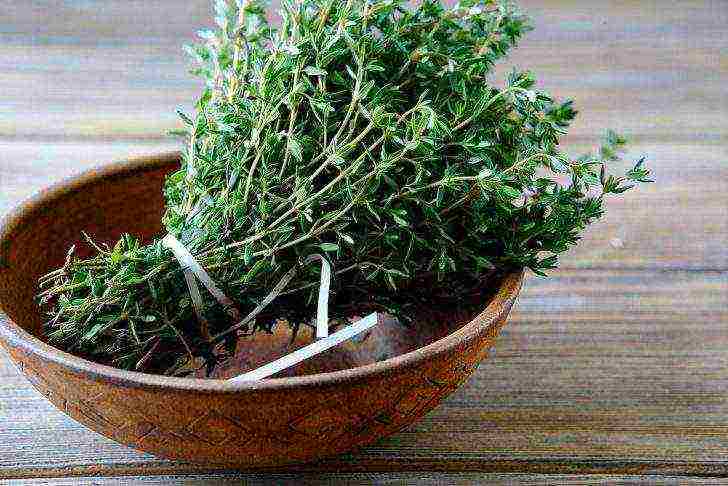
Dried thyme in bunches in the shade
Contraindications to thyme use
Since thyme has certain medicinal properties and is high in thymol, it is not recommended to get carried away by pregnant women. The seasoning can provoke an increase in uterine tone, which complicates the course of pregnancy.
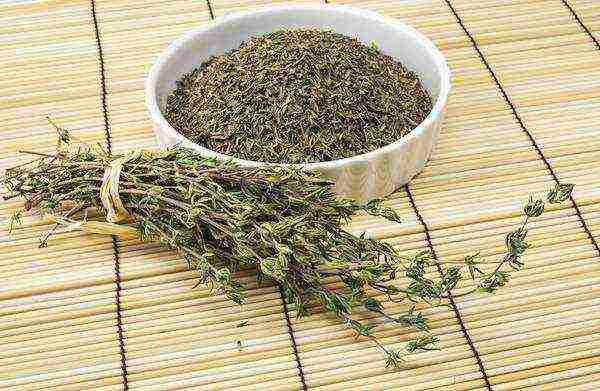
It is not recommended to consume thyme during pregnancy
Thyme is harmful for diseased kidneys, since thymol is somewhat toxic and will increase the load on the filtering organs. This is guaranteed to interrupt the course of remission and stimulate the exacerbation of the disease.
Conclusion
Try your hand at growing thyme and if your efforts are crowned with success, then you will receive not just an excellent replenishment of your collection of indoor plants, but a real natural mix of beauty and usefulness.
Photo gallery - thyme Video
Rating:
(
estimates, average:
out of 5)
Did you like the post? Share with your friends!
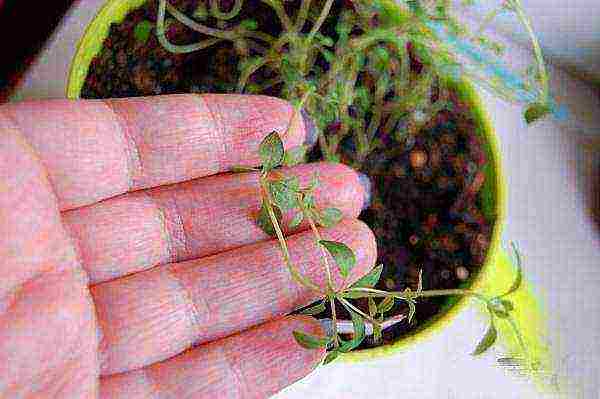 Many spices and herbs can be grown year-round on a windowsill, without the need for any special equipment and skills. Many seedlings can be obtained from one bag of seeds. thyme and share the aromatic spice in the pot with loved ones and neighbors. Thyme is used not only in cooking as a spicy aromatic additive, but also in cosmetology and folk medicine.
Many spices and herbs can be grown year-round on a windowsill, without the need for any special equipment and skills. Many seedlings can be obtained from one bag of seeds. thyme and share the aromatic spice in the pot with loved ones and neighbors. Thyme is used not only in cooking as a spicy aromatic additive, but also in cosmetology and folk medicine.
How to grow thyme from seeds at home?
Thyme (thyme) can be propagated and grown in two ways: by sowing seeds or by cuttings.If there is no mother bush, only the seed method of reproduction remains.
Anyone who is more or less familiar with the basics of floriculture can grow thyme on the windowsill. Thyme (thyme) is sown in spring or autumn.
For sowing, you need to take a small pot, no more than 15 cm high. Be sure to pour any drainage material on the bottom in order to prevent stagnation of water. Thyme roots do not tolerate excess moisture, they rot, as a result of which the plant may die. The drainage layer should be approximately 2-3 cm high.
Now you need to prepare the ground. Experts recommend adding perlite or vermiculite to the finished soil to regulate moisture and increase the air permeability of the soil. Thyme (thyme) grows well on purchased soil "For cacti". To improve the composition, a third of the volume of chernozem can be added to such purchased soil.
Before sowing, the soil must be moistened with a spray bottle, but not overfilled. Next, the seeds of thyme (thyme) from a bag are laid out on the soil surface and slightly deepened, but not more than 1 cm. The plantings are slightly moistened, covered with polyethylene to maintain a constant level of humidity. Periodically, crops need to be ventilated to avoid the formation of mold and the development of fungal diseases.
Until the thyme sprouts appear, it is best to keep the pot in a slightly shaded place, avoiding open sunlight. The fact is that the burning rays of the sun destroy seedlings.
The first sprouts of thyme appear about 10-20 days after sowing, and after another 2 months the strongest plants are left in the pot. If desired, weak sprouts are transplanted into separate pots for growing.
How to properly care for home-grown thyme?
Watering the seedlings should be moderate, without waterlogging, but excessively dry soil has an extremely negative effect on the development of plants. The grown and matured thyme seedlings are best placed on the south window, where the plants will have enough warmth. In insufficient light, the sprouts stretch out and wither. In addition, shade-grown thyme is less aromatic and grows poorly.
When the thyme grows up to 5 cm in height, be sure to feed it with mineral fertilizers. First, the soil is spilled with clean warm water, after which it is watered with a solution of mineral fertilizer. After each watering and feeding, the soil must be loosened without damaging the root system of the plant, which is located at the soil surface.
Thyme is demanding on heat and light, so the pot with the plant should be kept in a room where the temperature does not drop below 5 ° C heat.
Harvesting thyme
When the home-grown thyme blooms, you can start harvesting the spice. The stems and leaves of this plant are cut all year round as needed, but without getting carried away with a haircut, so as not to weaken the bush.
In the second year, the grown thyme bush can be planted in separate pots or cuttings. Growing thyme at home will always allow you to have fresh spice on the windowsill.
